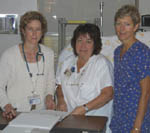NICU nurses probe secondary surfactant use
by Dick PetersonPublic Relations
Check the literature. There’s not a mention anywhere of the term “secondary surfactant deficiency (SSD).”
 Neonatologist
Dr. Doe Eicher, left, and neonatal nurse practitioners Robin Bissinger
and Cheryl Carlson review data collected on the outcomes of premature infants
treated for secondary surfactant deficiency. Their poster presentation
addressing the safety and short-term effects of secondary doses of surfactant
will be included at the Hot Topics in Neonatology conference later this
month in Washington, D.C.
Neonatologist
Dr. Doe Eicher, left, and neonatal nurse practitioners Robin Bissinger
and Cheryl Carlson review data collected on the outcomes of premature infants
treated for secondary surfactant deficiency. Their poster presentation
addressing the safety and short-term effects of secondary doses of surfactant
will be included at the Hot Topics in Neonatology conference later this
month in Washington, D.C.
Not until the July 1 issue of Journal of Perinatology where three case studies presented by MUSC neonatal nurse practitioners Robin Bissinger and Cheryl Carlson show the effective use of surfactant in the treatment of secondary respiratory failure after recovery from respiratory distress syndrome.
Surfactant, a fluid produced late in fetal life, is essential in reducing surface tension within the lungs of newborns allowing them to breathe. Premature infants born before they have produced enough of their own surfactant can experience respiratory distress and die. So neonatologists and neonatal nurse practitioners routinely administer a synthetic surfactant to aid the infants until they can begin producing their own.
“But sometimes an infection or pneumonia inactivates or alters the production of the infant’s own surfactant,” Bissinger said. This event that can send the infant into respiratory distress has led Bissinger and Carlson, with the help of neonatologist Doe Eicher, M.D., to investigate the safety and efficacy of administering surfactant a second time due to a secondary deficiency.
“We started by identifying cases of babies who were treated with surfactant secondarily,” Bissinger said. “We wanted to see if it was beneficial.”
The identification of the cases, which was done on the nurses’ own time, proved to be enough of an eye-opener to deserve publication in the Journal of Perinatology, an achievement heretofore unheard of for nurse practitioners.
Bissinger said that there has not been a pilot trial on secondary surfactant deficiency. “It’s not currently a term used in neonatology but is now being described by the investigators here at MUSC. The SSD pilot trial was completed a few months ago and with the help of Thomas Hulsey and Yvonne Michel, we have analyzed the data. The pilot trial demonstrated a significant improvement in oxygenation and ventilation in infants with secondary respiratory failure who are administered surfactant.”
As a result of their study and publication in the Journal of Perinatology, the nurse practitioners will present at the Hot Topics in Neonatology conference, sponsored by Ross Pharmaceuticals in Washington, D.C., in December. The poster presentation will address the safety and short-term effects of secondary doses of surfactant.
Bissinger said that a grant application is being written for a larger,
randomized clinical trial that she hopes will be a multi-disciplined study
involving neonatal nurse practitioners, neo-natologists and respiratory
therapists working together.
Friday, Dec. 3, 2004
Catalyst Online is published weekly, updated
as needed and improved from time to time by the MUSC Office of Public Relations
for the faculty, employees and students of the Medical University of South
Carolina. Catalyst Online editor, Kim Draughn, can be reached at 792-4107
or by email, catalyst@musc.edu. Editorial copy can be submitted to Catalyst
Online and to The Catalyst in print by fax, 792-6723, or by email to petersnd@musc.edu
or catalyst@musc.edu. To place an ad in The Catalyst hardcopy, call Community
Press at 849-1778.